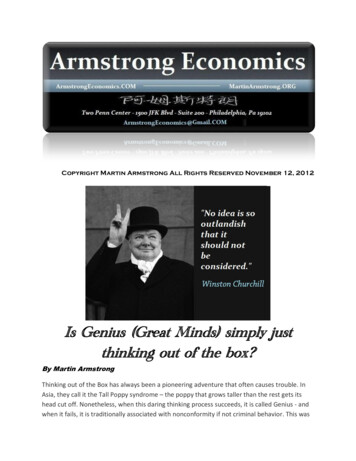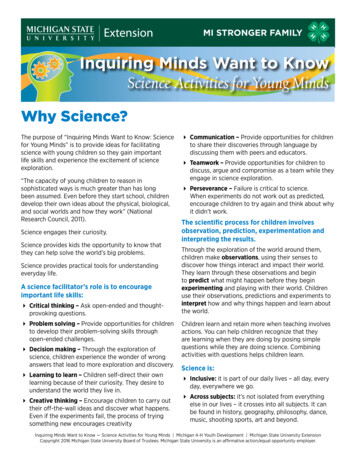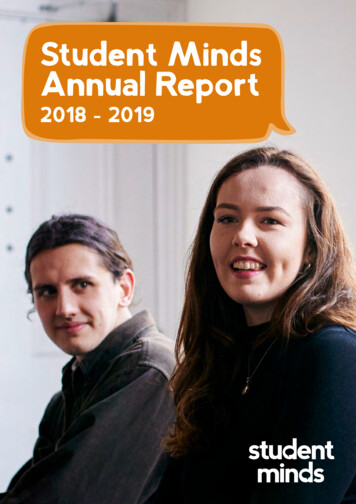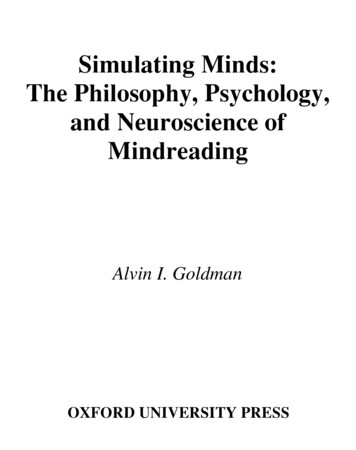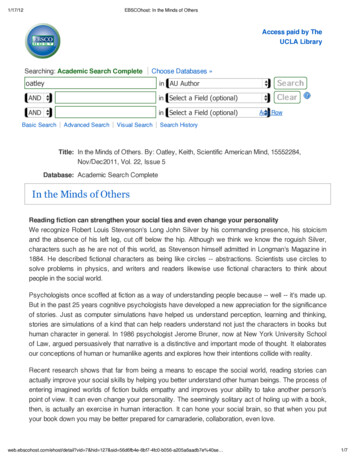
Transcription
1/17/12EBSCOhost: In the Minds of OthersAccess paid by TheUCLA LibrarySearching: Academic Search CompleteChoose Databases »in AU AuthorSearchANDin Select a Field (optional)ClearANDin Select a Field (optional)oatleyBasic SearchAdvanced SearchVisual SearchAdd RowSearch HistoryTitle: In the Minds of Others. By: Oatley, Keith, Scientific American Mind, 15552284,Nov/Dec2011, Vol. 22, Issue 5Database: Academic Search CompleteIn the Minds of OthersReading fiction can strengthen your social ties and even change your personalityWe recognize Robert Louis Stevenson's Long John Silver by his commanding presence, his stoicismand the absence of his left leg, cut off below the hip. Although we think we know the roguish Silver,characters such as he are not of this world, as Stevenson himself admitted in Longman's Magazine in1884. He described fictional characters as being like circles -- abstractions. Scientists use circles tosolve problems in physics, and writers and readers likewise use fictional characters to think aboutpeople in the social world.Psychologists once scoffed at fiction as a way of understanding people because -- well -- it's made up.But in the past 25 years cognitive psychologists have developed a new appreciation for the significanceof stories. Just as computer simulations have helped us understand perception, learning and thinking,stories are simulations of a kind that can help readers understand not just the characters in books buthuman character in general. In 1986 psychologist Jerome Bruner, now at New York University Schoolof Law, argued persuasively that narrative is a distinctive and important mode of thought. It elaboratesour conceptions of human or humanlike agents and explores how their intentions collide with reality.Recent research shows that far from being a means to escape the social world, reading stories canactually improve your social skills by helping you better understand other human beings. The process ofentering imagined worlds of fiction builds empathy and improves your ability to take another person'spoint of view. It can even change your personality. The seemingly solitary act of holing up with a book,then, is actually an exercise in human interaction. It can hone your social brain, so that when you putyour book down you may be better prepared for camaraderie, collaboration, even love.web.ebscohost.com/ehost/detail?vid 7&hid 127&sid 56d6fb4e-6bf7-4fc0-b056-a205a6aadb7e%40se 1/7
1/17/12EBSCOhost: In the Minds of OthersSocial SimulationsLong before computers were invented, stories functioned as the original virtual worlds. In 1594 WilliamShakespeare realized that a play essentially re-creates a social environment -- he used the term"dream." In A Midsummer Night's Dream, Shakespeare's characters live in an imagined land in whichdripping the juice of "a little western flower" into a sleeper's eye makes the sleeper fall in love with thefirst person he or she sees upon waking. In this dream world, the flower juice enables the selection of alife partner. Professor of English Elaine Scarry of Harvard University also advances the dream theme inDreaming by the Book. She argues that rather than simply doling out descriptions of a world, asuccessful fiction writer offers "instructions" to start up a kind of waking dream.But immersion in fiction need not be perceived as an isolating activity. Several years ago Raymond A.Mar, then a graduate student in psychology at the University of Toronto, decided to challenge thepopular conception that people who read a lot of fiction are socially withdrawn bookworms who usenovels as an escape from reality. Drawing on the social simulation idea, which I had described in twopublications in the 1990s, Mar wanted to know whether people who read a lot of fiction might actuallyhave better social skills than those who read little or none. Just as pilots gain practice with flightsimulators, he reasoned, people might acquire social experience by reading fiction.Along with our Toronto colleagues, psychologists Jacob Hirsh, Jennifer de la Paz and Jordan Peterson,Mar and I assessed the reading habits of 94 adults, separating fiction from nonfiction. Then we testedthe volunteers on two types of social skills: emotion perception and social cognition, for the former, weasked subjects to try to discern a person's emotional state from photographs of just the eyes [see boxon opposite page]. For the latter, participants answered questions about video clips of individualsinteracting -- for example, "which of the two children, or neither, in this clip belongs to the adult?" In thisstudy, published in 2006, we found that the more fiction people read, the better they were at perceivingemotion in the eyes and, to a lesser extent, correctly interpreting social cues. These results drew thefirst strong connection between fiction reading and social skills, although we were not yet sure whetherreading fiction was causing these individual differences or whether those differences existed in the firstplace.A year later Mar published a piece of evidence more directly supporting the idea that reading fiction canimprove social aptitude. Mar assigned 303 adults to read either a short story or an essay from the NewYorker. Then he gave all of them tests of both analytical and social reasoning. The former consisted oflogic problems in verbal form; the latter asked people to draw conclusions from hypothetical socialscenarios. Those who read the story performed better, on average, on the social reasoning test thanthose who read the nonfiction essay, suggesting that the fiction primed them to think about the socialworld. In contrast, the analytical reasoning scores were the same for both groups. I bus, even a briefbout of reading fiction can temporarily improve a person's social skills.A New PerspectiveGood social skills require having a well-developed theory of mind. Sometimes called mind reading,theory of mind is the ability to take the perspectives of Other people, to make mental models of others,and to understand that someone else might have beliefs and intentions that are different from your own.web.ebscohost.com/ehost/detail?vid 7&hid 127&sid 56d6fb4e-6bf7-4fc0-b056-a205a6aadb7e%40se 2/7
1/17/12EBSCOhost: In the Minds of OthersChildren start an to acquire this ability at about four years old, when they can separate what someoneelse knows from what they know themselves. Theory of mind continues to develop throughout life. Theability to gauge emotion from pictures of just the eyes correlates with theory-of-mind skills, as does thecapacity for empathy. Our 2006 study, with its test of eye expressions, suggests that the more fictionpeople read, the better they are at making mental models of others.Still, the association we found between reading fiction and social ability could simply have reflected anaffinity for fiction among people with good social skills. That is, devouring novels might be a result, not acause, of having a strong theory of mind. To test this possibility, in 2009 we published a repeat of ourearlier investigation with a separate group of 252 adults. This time, though, we measured theparticipants' so-called Big Five personality traits: extra-version, emotional stability, openness toexperience, agreeableness and conscientiousness. We also assessed their social networks (socialsupport), degree of social isolation and loneliness.People who scored high on the personality trait of openness to experience did read slightly more fictionthan those who scored higher on other traits. But when we controlled for this -- statistically subtractedout this tendency and the effects of other individual differences -- we still found a large and sig-nificantrelation between the amount of fiction people read and their empathic and theory-of-mind abilities; itlooked as if reading fiction improved social skills, not the other way round. Moreover, individuals whoread predominantly fiction were not lonely. In fact, they were less socially isolated and had more socialsupport than people who were largely nonfiction readers.In 2010 Mar, along with psychologists Chris Moore of Dalhousie University in Halifax and JenniferTackett of the University of Toronto, followed up this work on adults with a Study of S5 preschoolchildren. They found thatthe more fictional stories preschoolers listened to and the more fictional moviesthey saw, the better they were on five tests of children's theory of mind. In one such test, a child isshown a toy figure of an adult and a picture of a carrot and a cookie. The child is asked which kind ofsnack he or she prefers and is then told that the toy figure prefers the other snack. Then the childanswers the theory-of-mind question: The toy figure wants a snack, so which snack will the figurechoose? To be correct, children have to provide an answer that differs from their own desires.Although scores on these tests were better among kids who listened to more stories or watched moremovies, they were not higher among kids who watched a lot of television. The reason probably lies inthe fact that TV shows explore fewer topics and themes that require adopting a character's point ofview. They less often challenge the viewer to explain a protagonist's behavior, for example, or analyzethe reasons for an outcome that a protagonist did not expect.Our accumulating findings are providing increasing support for the hypothesis that reading fictionfacilitates the development of social skills because it provides experience thinking about other people.That is, we think the defining characteristic of fiction is not that it is made up but that it is about human, orhumanlike, beings and their intentions and interactions. Reading fiction trains people in this domain, justas reading nonfiction books about, say, genetics or history builds expertise in those subject areas.web.ebscohost.com/ehost/detail?vid 7&hid 127&sid 56d6fb4e-6bf7-4fc0-b056-a205a6aadb7e%40se 3/7
1/17/12EBSCOhost: In the Minds of OthersTo test this hypothesis more fully, we plan to assign people to read either only fiction or only nonfic-tionbooks for several months. We will measure the social awareness of both groups before and after thereading period. If our theory is correct, the fiction readers should show significant improvement on socialmeasures, and their scores should increase more than those who were exposed to just nonfiction.Getting into CharacterFiction gets its power from a reader's emotional connection to the characters in a story -- in a word,empathy. Scientists have traced the roots of some aspects of that tie in the brain. In a 2004 study, forexample, neuroscientist Tania Singer and her colleagues from University College London found, usingfunctional MRI, that brain areas such as the anterior insula and anterior cingulate cortex become activeboth when we feel pain and when we know that someone we love is in pain. These areas seem involvedin the emotional aspects of pain.The emotional empathy that is critical to our day-to-day relationships also enables us to pictureourselves living as the characters do when we read fiction. In fact, recent brain scans reveal that weinternalize what a character experiences by mirroring those feelings and actions ourselves. In a studypublished in 2009 psychologists Nicole Speer, Jeremy Reynolds, Khena Swallow and Jeff Zacks ofWash ington University in St. Louis asked 28 volunteers to recline in an fMRI scanner and read a shortstory, presented one word at a time on a screen. When a subject read about something the protagonistdid, the researchers found that the reader's brain responded as if he or she were performing the sameaction. When the words of a passage were about picking up or putting down an object -- for instance,"Raymond laid down his pencil" -- regions associated with grasping and letting go of an object with thehands were activated. These areas included the hand area of the premotor (motor planning) and of thesomatosensory (body-sensing) cortices.Other researchers have tried to home in on how fiction might tap into brain processes governing theoryof mind. If narrative augments our ability to understand others, the brain regions concerned withfollowing a storyline should overlap with those recruited in theory-of-mind tasks. To test this idea, earlierthis year Mar, now at York University in Toronto, published a statistical review of 86 brain scanningstudies in which participants either had to comprehend a story, perform a theory-of-mind task based ona narrative or carry out a theory-of-mind task that did not involve a story. By comparing the brain areasacross the studies, Mar identified a large group of structures spanning disparate areas of the brain thatall three tasks seemed to recruit. These regions, he concluded, make up a "core mentalizing network"that enables the understanding of others' mental events in life as well as in a story.Such investigations support the idea that when we read fiction we put aside out own concerns and plansand adopt those of the story's protagonist. Doing so allows us to understand a story's events from thecharacter's point of view. We do not actually ex-perience the character's emotions -- after all, thecharacter is an abstraction. Rather we feel our own emotions in response to the yearnings, actions andcircumstances the writer describes. The trajectory of these emotions keeps us turning the pages orglued to the screen. [For more on the power of stories, see "The Secrets of Storytelling: Why We Love aGood Yarn," by Jeremy Hsu; SCIENTIFIC AMERICAN MIND, August/September 2008.]web.ebscohost.com/ehost/detail?vid 7&hid 127&sid 56d6fb4e-6bf7-4fc0-b056-a205a6aadb7e%40se 4/7
1/17/12EBSCOhost: In the Minds of OthersChanging PersonalityThe brain's emotional responses to good literature do more than forge a connection with a nonexistentpersonality -- they can even alter the reader's sense of self. In a 2009 study Peterson and I, along withToronto psychologists Maja Djikic and Sara Zoeter-man, randomly assigned 166 people to read eitherthe short story by Anton Chekhov entitled "The Lady with the Little Dog" or a version of it that Djikicrewrote in the style of a nonaction report. In the story, a banker named Gomov meets a young woman,Anna, at the Russian seaside resort of Yalta as she is walking her dog. The two begin an affair. Afterthey go home to their spouses, to their surprise, the affair refuses to fade in their minds. Gomov andAnna meet from time to time and long to be united, but the story ends without resolution. Djikic's version,written as a report from a divorce court, contained exactly the same information and was the samelength and level of reading difficulty. Readers judged it to be just as interesting as Chekhov's story,though not as artistic.Before and after reading the texts, the participants took a personality test that measured the Big Fivetraits and rated the intensity with which they felt 10 different emotions -- sadness, anxiety, happiness,and so on. As compared with those who read the report, those who read the story underwent small butmeasurable personality changes. Participants changed in different ways: some became more or lessopen to experience, for example, whereas others were more or less agreeable after exposure to thestory. The degree of personality change paralleled the amount of emotional change a participantexperienced during reading. As with all good literature, Chekhov's story prompted people to think andfeel in new ways, but the particular feelings and thoughts it evoked depended on the reader.Only the story version seemed to enable readers to empathize with Gomov and Anna. The properties offictional narrative invite identification with characters in ways that nonfiction usually does not. Great art,it seems, may prompt perturbations in the usually stable structure of personality. Although thepersonality changes we found were probably temporary, as people spend more time reading fiction theymay become, say, more open and perceptive about others in general.We may often think of stories as diversions. Bur how we engage with them involves the same mentalprocesses that enable us to interact with others in daily life. Entering the simulated worlds of stories andengaging with the minds of their characters changes us. Because of their power over the mind, storiesmay be useful in the development of interpersonal skills and relationships among children andadolescents. And no matter your age, curling up comfortably with a novel in an armchair may do yourmind -- and social life -- a bit of llyrichnovels,visitThe solitary act of holing up with a book is actually an exercise in human interaction.We internalize what a character experiences by mirroring those feelings and actions.FAST FACTSBookworm Meets Socialiteweb.ebscohost.com/ehost/detail?vid 7&hid 127&sid 56d6fb4e-6bf7-4fc0-b056-a205a6aadb7e%40se 5/7
1/17/12EBSCOhost: In the Minds of OthersReading stories can fine-tune your social skills by helping you better understand other human beings.Entering imagined worlds builds empathy and improves your ability to take another person's point ofview.A love affair with narrative may gradually alter your personality -- in some cases, making you more opento new experiences and more socially aware.(The Author)KEITH OATLEY is professor emeritus of cognitive psychology at the University of Toronto and is afellow of the Royal Society of Canada. His most recent novel is Therefore Choose (Goose Lane, 2010).Stories on the MindThe brain responds to fiction as if a reader were feeling or acting just as the character is in the story.Scientists correlated passages displayed in a functional MRI scanner with brain activity. The prefrontalcortex, an area behind the forehead concerned with goal-setting, reacted when a character initiated anew goal. The temporal cortex, at the brain's sides, responded to character switches and goal-directedactions. Other parts reacted to allusions to time, or to changes in a character's spatial location ordealings with objects, in keeping with their regular roles.CharacterAs soon as Mrs. Logan made a check mark on his paper, Raymond hurried back to his desk.GoalRaymond crumpled the paper, seemingly without any anxiety.ObjectRaymond picked up his English workbook Space and returned to the teacher's desk.Multiple AspectsResponds to various features of the storyline.TimeHe walked briskly.(Further Reading)* Why Fiction May Be Twice as True as Fact: Fiction as Cognitive and Emotional Simulation. KeithOatley in Review of General Psychology, Vol. 3, No. 2, pages 101-117; June 1999.* Exploring the Link between Reading Fiction and Empathy: Ruling out Individual Differences andExamining Outcomes. Raymond Mar, Keith Oatley and Jordan Peterson in Communications: TheEuropean Journal of Communication Research, Vol. 34, No. 4, pages 407-428; December 2009.web.ebscohost.com/ehost/detail?vid 7&hid 127&sid 56d6fb4e-6bf7-4fc0-b056-a205a6aadb7e%40se 6/7
1/17/12EBSCOhost: In the Minds of Others* On Being Moved by Art: How Reading Fiction Transforms the Self. Maja Djikic, Keith Oatley, SaraZoeterman and Jordan Peterson in Creativity Research Journal, Vol. 21, No. 1, pages 24-29; 2009.* The Neural Bases of Social Cognition and Story Comprehension. Raymond Mar in Annual Review ofPsychology, Vol. 62, pages 103-134; 2011.* Such Stuff as Dreams: The Psychology of Fiction. Keith Oatley. Wiley-Blackwell, 2011.* The psychology of fiction: www.onfictlon.caAlthough people usually read by themselves, fiction readers are not lonely. In fact, they tend to havemore social support than do readers of nonfiction.Anxious? Annoyed? A person's ability to correctly read an expression from a snapshot of just the eyesreflects his or her social skills. Fiction fans do well at this task. Test yourself spxReading fiction builds a person's capacity for empathy and improves her ability to understand the mentalstates of others. A "core mentalizing network" in the brain enables the latter skill. By Keith OatleyCopyright of Scientific American Mind is the property of Scientific American and its content may not becopied or emailed to multiple sites or posted to a listserv without the copyright holder's express writtenpermission. However, users may print, download, or email articles for individual use.New: EBSCOhost iPhone and Android ApplicationsEBSCO Support SiteCopyrightPrivacy PolicyTerms of Use 2012 EBSCO Industries, Inc. All rights reserved.web.ebscohost.com/ehost/detail?vid 7&hid 127&sid 56d6fb4e-6bf7-4fc0-b056-a205a6aadb7e%40se 7/7
In the Minds of Others. By: Oatley, Keith, Scientific American Mind, 15552284, Nov/Dec2011, Vol. 22, Issue 5 Academic Search Complete In the Minds of Others Reading fiction can strengthen your social ties and even change your personality We recognize Robert Louis Stevenson's Long John Silver by his commanding presence, his stoicism



